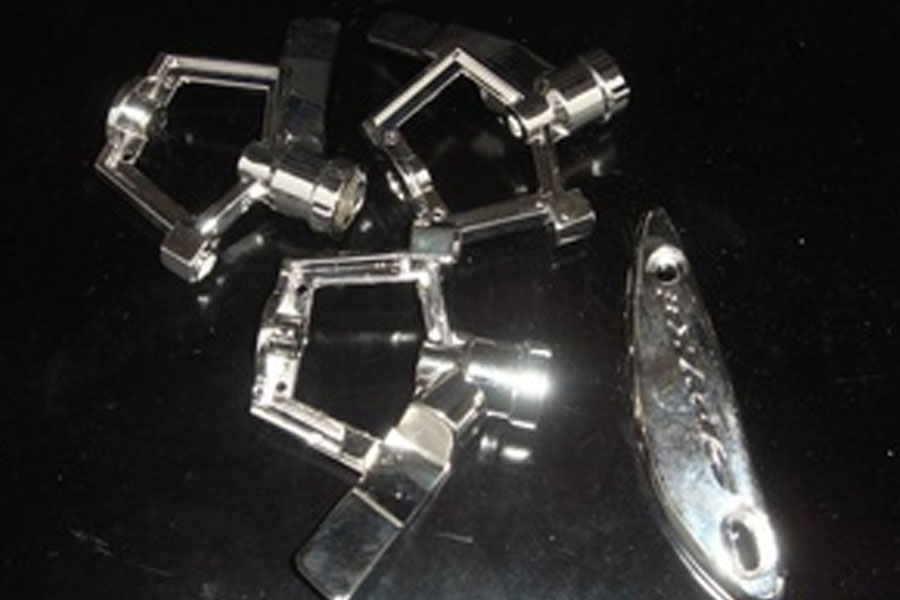The Surface Treatment Of Aluminum Alloy Die Casting Parts
Deashing agent: ZHLB-03 aluminum alloy die-casting deashing agent can quickly remove the black compounds such as silicon, copper, magnesium, and manganese remaining on the surface of the product during alkali corrosion or chemical polishing. For subsequent surface treatment (such as painting, electroplating, chemical conversion coating or anodic oxidation, etc.) procedures, provide a good clean substrate surface to improve the bonding force between the film layer and the substrate.
Degreasing agent: AC acid degreasing agent and LC weak alkaline degreasing agent are available; its main feature is strong degreasing performance, no corrosion to die castings, and ensuring the machining accuracy of die castings.
Alkali corrosive agent: Provide special alkali corrosive for ALC castings, which is characterized by effectively removing oxidation on the surface of die castings without over-corrosion.
Polishing agent: ZPGLB-03 die casting aluminum chemical polishing agent is used for polishing die-casting parts. It has the characteristics of enhancing surface gloss, deburring, and eliminating non-uniform components on the surface of die-casting parts.
Oxidant: Provide chromium-containing chemical treatment agent, the oxide film produced can effectively improve the corrosion resistance of the product and enhance the adhesion to the paint film (such as spray paint, electrophoretic coating, etc.).
Hard anode oxidizer: special additives for the anodization of die castings such as 2024, 7075, ZL104, ZL112, 6061, ADC12, etc.
The latest development of magnesium alloy surface treatment technology
Because magnesium alloys are extremely active and often have a layer of oxide on the surface, the surface treatment of magnesium alloys is difficult. Special treatment methods must be used. The existing surface treatment technology is immature, often making the alloy surface rough and using a lot of non-environmentally friendly chemicals. In recent years, advanced surface treatment technologies for magnesium alloys have seen new developments.
The technology developed includes three parts: electroplating, conversion layer and anodizing. The surface treatment of magnesium alloy is mainly to improve the appearance of the product and improve the wear resistance and corrosion resistance. Its functions are as follows:
- (a) Decorative surface;
- (b) Form a protective layer to prevent the magnesium alloy from being exposed to the air;
- (c) Fill and modify the small holes on the surface of die castings;
- (d) Increase the adhesion between the magnesium alloy substrate and the organic coating;
- (e) Improve wear resistance;
(f) Isolate magnesium alloy from contact with other metals to prevent electrochemical corrosion.
When choosing an appropriate surface treatment process, you must first consider the needs of the product, such as surface conductivity, wear resistance, product application environment, and other components of the selected magnesium alloy material. Magnesium alloy surface treatment technology is aimed at the above points.
1 Electroplating
Magnesium alloy electroplating is mainly divided into two categories. One is electroless nickel deposition directly after the alloy is activated; on the other hand, it can also be electroplated after zinc deposition. The relevant process is as follows:
Direct electroless nickel deposition method
Degreasing → pickling → activation 1 → activation 2 → electroless nickel deposition → heat treatment → copper electroplating → other electroplating
Zinc Immersion Method
Degreasing → pickling → activation 1 → activation 2 → sinking zinc → copper electroplating → other electroplating
After pre-treatment, the magnesium alloy can be plated with the required metal according to the product requirements, and a more diversified and better functional coating can also be obtained through vacuum ion plating. The surface of the magnesium alloy after electroplating treatment can finally be bright, good conductivity, good adhesion, and can pass the salt spray test for more than 100 hours.
2 Anodizing
The biggest advantage of magnesium alloy anodic oxide film is its hardness, excellent wear resistance and corrosion resistance, and insulation. The process is as follows:
Degreasing → pickling → anodizing → dyeing
Through special equipment and electrolyte, select the appropriate voltage to generate plasma (Plasma) and micro arc (MicroArc) during the oxidation process, so that a dense and hard ceramic oxide layer is formed on the surface of the magnesium alloy, and it can pass more than 100 Hour salt spray test. The surface of the magnesium alloy after this treatment can be dyed with reference to general aluminum anodization, or it can be directly covered with organic paint or other types of coatings.
3 Conversion layer
The conversion layer of the magnesium alloy can bring short-term protection and corrosion resistance to the surface of the magnesium alloy. At the same time, it can also become a strong bottom layer between the alloy and the organic coating, so that the organic coating has better adhesion. Regarding the conversion layer, chromization is the most commonly used method, and the effect is also the best; however, due to environmental issues, the use of hexavalent chromium (Cr6+)-free technology is a must first consideration. Therefore, phosphating has been used to replace the inherent chromium, and certain achievements have been made. Phosphated magnesium alloys can pass the 24-hour neutral salt spray test, and with the organic coating on the surface, the salt spray test can even exceed 300 hours. This phosphating layer can also improve the adhesion of magnesium alloys and paints. Focus on.
